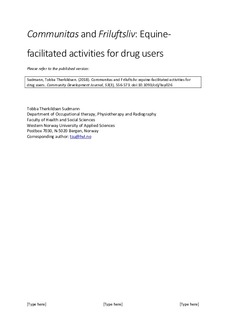| dc.contributor.author | Sudmann, Tobba Therkildsen | |
| dc.coverage.spatial | Norway | nb_NO |
| dc.date.accessioned | 2019-03-18T08:10:41Z | |
| dc.date.available | 2019-03-18T08:10:41Z | |
| dc.date.created | 2018-06-09T11:03:37Z | |
| dc.date.issued | 2018 | |
| dc.identifier.citation | Sudmann, T. T. (2018). Communitas and Friluftsliv: Equine-facilitated activities for drug users. Community Development Journal, 53, 556-573. | nb_NO |
| dc.identifier.issn | 0010-3802 | |
| dc.identifier.uri | http://hdl.handle.net/11250/2590372 | |
| dc.description | This is a pre-copyedited, author-produced version of an article accepted for publication in Community Development Journal following peer review. The version of record Sudmann, T. T. (2018). Communitas and Friluftsliv: equine-facilitated activities for drug users. Community Development Journal, 53, 556–573, is available online at: https://academic.oup.com/cdj/article/53/3/556/4994218 | nb_NO |
| dc.description | Available: 2020-05-09. | |
| dc.description.abstract | A green care farm creates a temporal “thrown-togetherness”. Farm-based welfare services provide contact with animals and nature, supportive environments, social acceptance, fellowship with other participants, and meaningful activities. Most green care farms in Norway have horses, and equine-assisted activities are known to add value to green care for people with addiction and/or mental health problems. Farms facilitate connectedness between place and people, create “place-events”, and resemble friluftsliv activities. Friluftsliv creates a different temporality and rhythm, where nature is cared for and
befriended. This article presents and discusses two different approaches to equine-assisted activity for drug-users from an inpatient treatment programme, and for guests from a dropin centre, respectively. Participation was non-conditional, and following the world view underpinning community work, the participants’ evaluations of benefits are the most significant outcome measure. The equine-assisted communities are both ephemeral and long-lasting, and have given many participants the motivation to stay in therapy and reduce their drug use, or they have gained access to new social arenas, volunteering, or to sheltered employment. Community work at farms offers possibility for communitas, i.e. a groups pleasure in sharing common experiences with one’s fellows, learning-in-context, friluftsliv and serendipitous benefits – the last adding an important contribution to participants’ health and well-being. | nb_NO |
| dc.language.iso | eng | nb_NO |
| dc.subject | friluftsliv | nb_NO |
| dc.subject | horses | nb_NO |
| dc.subject | communitas | nb_NO |
| dc.subject | drug users | nb_NO |
| dc.subject | low threshold activities | nb_NO |
| dc.title | Communitas and Friluftsliv: equine-facilitated activities for drug users | nb_NO |
| dc.type | Journal article | nb_NO |
| dc.type | Peer reviewed | nb_NO |
| dc.description.version | acceptedVersion | nb_NO |
| dc.subject.nsi | VDP::Medisinske Fag: 700::Helsefag: 800::Andre helsefag: 829 | nb_NO |
| dc.source.pagenumber | 556-573 | nb_NO |
| dc.source.volume | 53 | nb_NO |
| dc.source.journal | Community Development Journal | nb_NO |
| dc.source.issue | 3 | nb_NO |
| dc.identifier.doi | 10.1093/cdj/bsy026 | |
| dc.identifier.cristin | 1590145 | |
| cristin.unitcode | 203,11,2,0 | |
| cristin.unitname | Institutt for helse og funksjon | |
| cristin.ispublished | true | |
| cristin.fulltext | postprint | |
| cristin.qualitycode | 1 | |
| dc.date.embargoenddate | 2020-05-09 | |
